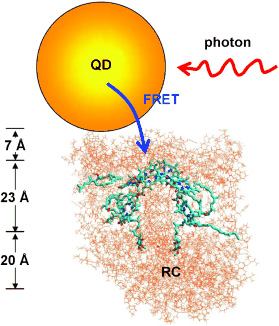TCD Physicist Collaborates on International Nanoscience Research Project Aimed at Increasing Light Efficiency
Posted on: 15 October 2010
Harnessing solar energy continues to be a challenging and inefficient process. New research led by the Head of the School of Physics at TCD and Principal Investigator at the Centre for Research on Adaptive Nanostructures and Nanodevices (CRANN), Professor John Donegan, has uncovered a new approach to increasing light efficiency by emulating the photosynthetic craft of plants, algae and bacteria by using quantum dots which are inorganic nanocrystals. The research, which was recently published in the leading German-based chemistry journal Angewandte Chemie International, involved international collaboration with a team of Spanish, French and Russian scientists.
In organisms, the first step of photosynthesis is the absorption of light by an antenna, a complex of proteins and pigments that is brought into an electronically excited state by light energy. This energy can then be transferred by means of a process called Förster Resonance Energy Transfer (FRET), a mechanism describing energy transfer between two molecules, to reaction centres where it is used as fuel. Working on this principle Professor Donegan and his team successfully equipped the photosynthetic centre from a purple bacterium with a light-harvesting antenna consisting of a quantum dot. These tiny nanoscopic crystals behave more like molecules than macroscopic solid objects, allowing scientists an opportunity to manage and maximise the harvesting of light energy.

Working process of a synthetic photosynthetic system.
Previous synthetic antennas used organic dye molecules which have the disadvantage of capturing too small a range of wavelengths from sunlight and prove to be unstable under long-term exposure to solar radiation. The electronic and optical properties of quantum dots, however, including the wavelengths that they absorb, can largely be made to order because these are dependent on the size, shape and composition of the dot. The materials that the researchers used were chosen because they fluoresce or give off light when exposed to solar radiation, remain stable in the long term and could absorb a broad range of sunlight. By manipulating the photosynthetic centre of purple bacterium the researchers were able to pass the absorbed energy over to the reaction centre through FRET, paving the way for new approaches to synthetic photosynthetic systems.
Commenting on the research, Professor Donegan said: “This is an important result showing that we can fabricate synthetic centres that can further enhance the photosynthetic process itself. We now must strive to develop this work to produce novel optical devices based on these hybrid structures”.
Along with Professor John Donegan, the main researchers involved in the project included Igor Nabiev of the NanoGUNE Research Centre in San Sebastian, Spain, and Alexander Govorov of Ohio University, USA. Professor Nabiev was an SFI Funded Walton Research Fellow based in CRANN from 2008-10. CRANN was established in 2004 and is Ireland’s first purpose-built nanoscience research institute. The full paper on the use of fluorescent quantum dots as artificial antennas for enhanced light harvesting can be viewed online.
